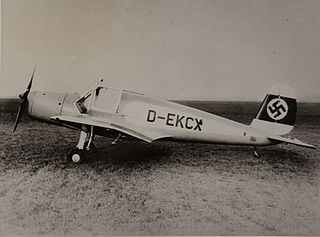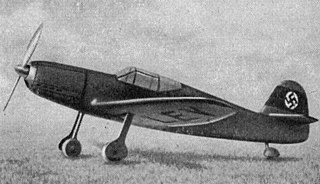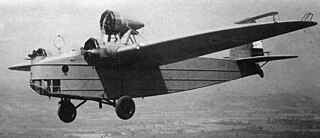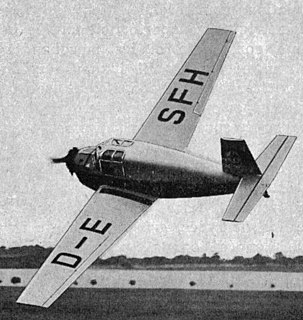Operators


| Kl 31 | |
|---|---|
| Role | Touring aircraft |
| National origin | Germany |
| Manufacturer | Klemm |
| Designer | Robert Lusser |
| First flight | 1931 |
The Klemm Kl 31 was a touring aircraft, developed in Germany in the early 1930s. It was a conventional, low-wing cantilever monoplane with four seats in an enclosed cabin. The fixed, tailskid undercarriage had divided mainwheel units. The fuselage was built from welded steel tube, while the wings were wooden. Some Kl 31s saw service with the Luftwaffe as training and liaison aircraft.
General characteristics
Performance

The Heinkel He 70 Blitz ("lightning") was a German mail plane and fast passenger monoplane aircraft of the 1930s designed by Heinkel Flugzeugwerke, which was later used as a bomber and for aerial reconnaissance. It had a brief commercial career before it was replaced by larger types. The He 70 had set eight world speed records by the beginning of 1933.

The Fieseler Fi 5 was a single-engined two-seat sportplane of the 1930s. It was produced by the German aircraft manufacturer Fieseler Flugzeugbau, which was started by the World War I fighter ace and German aerobatic star, Gerhard Fieseler.

The Dornier Do 23 was a German medium bomber of the 1930s.

The Dornier Do 22 was a German seaplane, developed in the 1930s. Despite good performance, it was built only in small numbers and entirely for the export market. The type was operated in the Second World War by Greece, Yugoslavia and Finland.

The Heinkel He 45 was a light bomber produced in Germany in the early 1930s, one of the first aircraft adopted by the newly formed Luftwaffe. Its appearance was that of a conventional biplane and included seating for pilot and gunner in tandem, open cockpits. Developed in parallel with the He 46, it appeared in 1931 as a general-purpose biplane and was employed mainly as a trainer, but was also used by the Luftwaffe for reconnaissance and light bombing duties. Production of this plane totalled 512 aircraft, including those built under licence by Gotha, Focke-Wulf, and BFW.

The Heinkel He 46 was a German World War II-era monoplane designed in 1931 for the close reconnaissance and army co-operation roles. While it served with the Luftwaffe's front-line units only briefly at the start of World War II, the He 46 served as late as 1943 as a nighttime nuisance bomber and with the Hungarian Air Force.

The Klemm Kl 35 is a German sporting and training aeroplane developed as a successor to the Kl 25. A product of Klemm Leichtflugzeugbau Gmbh it shared the same single-engine, cantilever low-wing configuration as the earlier machine, the major difference being the introduction of an inverted gull wing.

The Heinkel He 72 Kadett ("Cadet") was a German single-engine biplane trainer of the 1930s.

The Bölkow Bo 207 was a four-seat light aircraft built in West Germany in the early 1960s, a development of the Klemm Kl 107 built during World War II.

The Arado Ar 79 was a German aircraft of the 1930s, designed as an aerobatic two-seat trainer and touring aircraft.

Klemm L 25, later Klemm Kl 25 was a successful German light leisure, sports and training monoplane aircraft, developed in 1928. More than 600 aircraft were built, and manufacturing licenses were sold to the United Kingdom and the United States.

The Gotha Go 149 was a military aircraft developed in Germany in the mid-1930s for training fighter pilots. It was a conventional low-wing cantilever monoplane with tailwheel undercarriage, the main units of which retracted inwards. The wing was wooden, while the monocoque fuselage was metal. Two prototypes were constructed, and an armed version was also proposed as a light home-defence fighter (Heimatschutzjäger) armed with two 7.92 mm (.312 in) MG 17 machine guns, but the Luftwaffe did not purchase either version of the design, and no further examples were built.

The Klemm Kl 36 was a 1930s German four-seat cabin touring and competition monoplane designed and built by Klemm.

The Dornier Do Y was a German bomber of the 1930s, the second bomber design by Dornier Flugzeugwerke.

The Klemm Kl 32 was a touring aircraft, developed in Germany in 1932, based on the Klemm Kl 31 as a competitor in the Challenge 1932 touring aircraft competition.
The Klemm Kl 105 was a two-seat sport aircraft developed in Germany in 1938. It was a low-wing cantilever monoplane of conventional design with fixed, tailskid undercarriage, and side-by-side seating for two within an enclosed cockpit. Construction throughout was of wood, with the fuselage built using a new semi-monocoque technique which Klemm patented. Plans to produce the design in series were abandoned with the outbreak of the Second World War.

The Siebel Fh 104 Hallore was a small German twin-engined transport, communications and liaison aircraft built by Siebel.

The Siebel Si.202 Hummel ("Bumble-bee") was a German light sportsplane of the late 1930s. It was an angular low-wing monoplane, which could be powered by a variety of small engines.

The Gotha Go 150 was a light aircraft designed at the German company Gothaer Waggonfabrik in the late 1930s. It was intended for civilian use, but ended up being used as a military trainer.
The Gotha Go 241 was a low-wing twin-engined four-seat transport aircraft manufactured by Gothaer Waggonfabrik in the early 1940s and intended for the general aviation market.